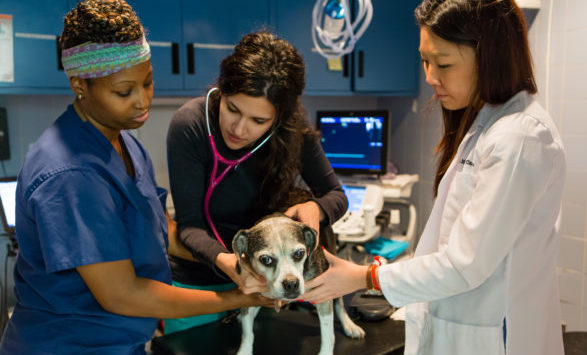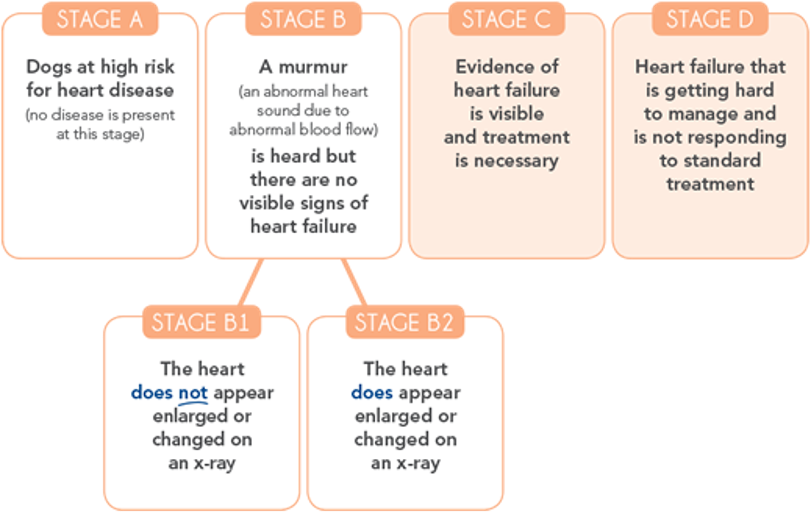Chronic Degenerative Valve Disease in Dogs

Background
Chronic degenerative valve disease (CVD), also known as endocardiosis, is the most common type of heart disease in dogs. It occurs when the heart valves, which control blood flow between the chambers of the heart, become thickened and inflexible. Their distorted shape prevents the valves from shutting properly. Blood then leaks through the abnormal valves resulting in backflow, leading to increased pressure within the heart chambers or blood vessels. This condition commonly affects the mitral or tricuspid valves and is also known as myxomatous valve degeneration.
In some dogs, progressive degeneration of the heart valves leads to fluid buildup in and around the lungs and in the abdomen. The fluid buildup as a result of impaired heart function is known as congestive heart failure.
Risk Factors
CVD is common in older, small-breed dogs. While the cause of CVD is unknown, there appears to be a genetic component, with the following breeds more prone to developing the condition:
- Cavalier King Charles spaniels
- Dachshunds
- Miniature and toy poodles
Signs
A heart murmur is generally the earliest sign of CVD, with future symptoms not appearing for another 3-4 years. As the disease progresses, you may see the following:
- Reluctance to move or exercise
- Difficulty breathing
- Rapid breathing > 40 breaths per minute
- Fainting
Diagnosis
A heart murmur can be detected during your dog’s regular exam using a stethoscope. In order to diagnose CVD, your veterinarian may order an echocardiogram which uses sound waves to non-invasively create an image of the heart. Color-flow Doppler echocardiography can detect valve leaks by detecting the direction of blood flow. Your veterinarian may also recommend additional cardiac tests, including chest radiographs (x-rays) which can reveal the severity of the disease by looking at heart size, an electrocardiogram to detect abnormal heart rhythms, and a blood test for BNP, a hormone produced by the heart which increases when the heart muscle is stretched excessively as it does in congestive heart failure.
Treatment
Veterinary cardiologists use a standardized grading scale to classify the severity of diseases and streamline treatment protocols. The following grading scale is broken into four stages to address dogs with CVD:
Treatment for CVD begins when a dog is classified as Stage B2, when both a heart murmur is detected and the heart appears enlarged or changed on an x-ray. Dogs with Stage B2 heart disease are commonly treated with an inodilator such as pimobendan. Some dogs are given an ACE inhibitor. When dogs reach Stage C, the accumulation of fluid in the lungs also known as pulmonary edema, diuretics are added to the treatment regimen. Your veterinary cardiologist will have an individualized plan for your dog depending on the stage of the disease.
Prevention
While CVD is not preventable, pet owners can take steps to help their dog be heart healthy. This includes keeping your dog at a healthy body weight, exercising your dog daily, and taking your dog for their annual check-up with your veterinarian. If your veterinary cardiologist makes a specific dietary recommendation, be sure to feed your dog only the recommended foods. Both an early diagnosis and medication can help prolong the quality of life for dogs with heart disease.
Make an Appointment

Cardiology
AMC’s world-class team of cardiologists diagnose and treat pets with congenital or acquired heart disease and pets who cough or have breathing problems. Our team of board-certified veterinarians is trained to rapidly diagnose and effectively manage heart failure and many other diseases that may develop during the course of a pet’s life.
Learn More






























